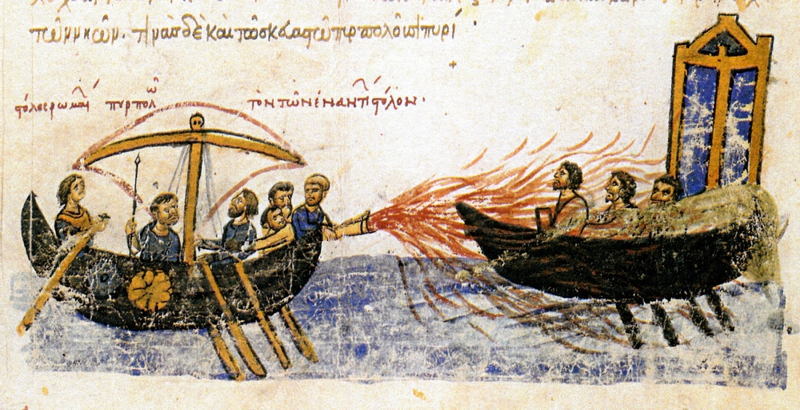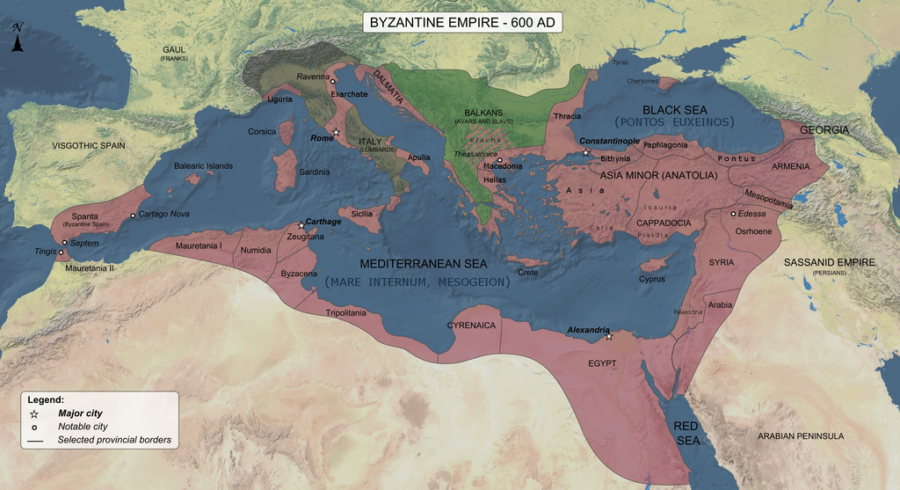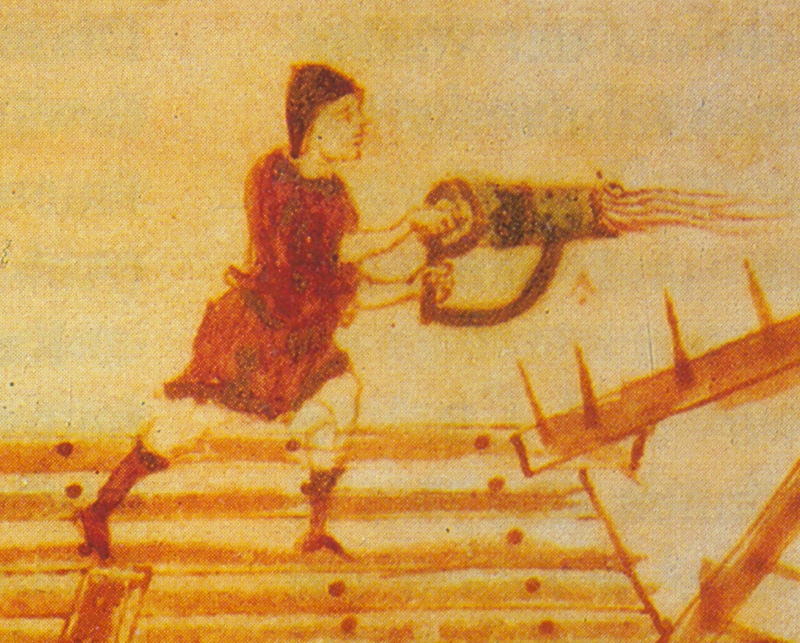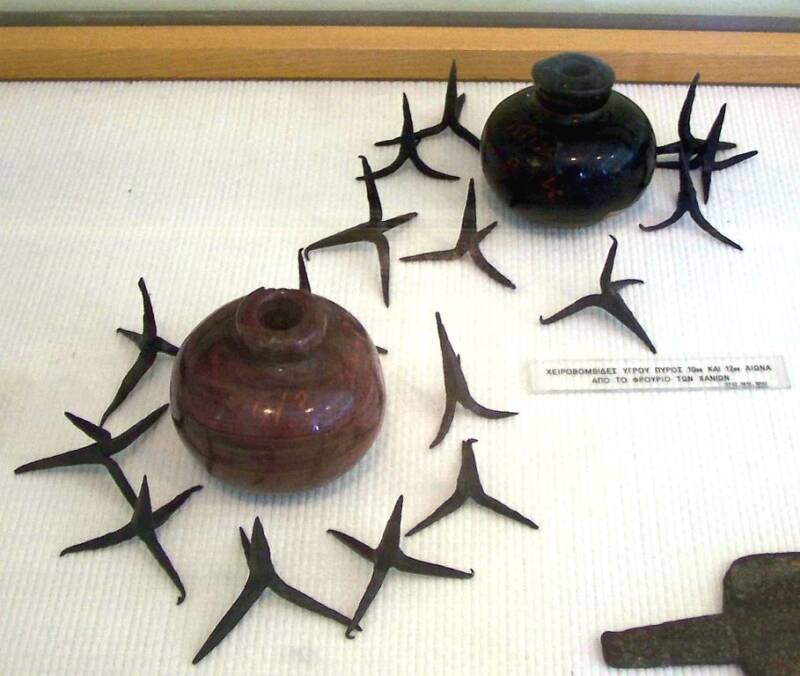Though historians know that Greek fire was a devastating incendiary weapon used by the Byzantines starting in the 7th century C.E., its recipe remains mysterious to this day.
Greek fire was a devastating incendiary weapon used by the Byzantine Empire to defend themselves against their enemies.
The Byzantine people used this 7th-century compound to repel Arab invasion for years, particularly at sea. While Greek fire wasn’t the first incendiary weapon, it was arguably the most historically significant one.

Wikimedia CommonsA depiction of Greek fire being used at sea against Thomas the Slav, a 9th-century rebel Byzantine general.
What’s truly fascinating about Greek fire is that armies who captured the liquid concoction were unable to recreate it for themselves. They also failed to recreate the machine that delivered it. To this day, nobody knows exactly what ingredients went into the mixture.
A Powerful Ancient Weapon
Greek fire was a liquid weapon devised by the Byzantine Empire, which was the surviving, Greek-speaking eastern half of the Roman Empire.

Wikimedia CommonsThe Byzantine Empire in 600 A.D. It would suffer continued attacks throughout the centuries, culminating in the fall of Constantinople in 1453.
Also called “sea fire” and “liquid fire” by the Byzantines themselves, it was heated, pressurized, and then delivered via a tube called a siphon. Greek fire was mainly used to light enemy ships on fire from a safe distance.
What made the weapon so unique and potent was its ability to continue burning in water, which prevented enemy combatants from dousing the flames during naval wars. It’s possible that the flames burned even more vigorously upon contact with water.
To make matters worse, Greek fire was a liquid concoction that stuck to whatever it touched, be it a ship or human flesh. It was only extinguishable with one bizarre mixture: vinegar mingled with sand and old urine.
The Invention Of Greek Fire

Wikimedia CommonsA hand-held Greek fire flamethrower, depicted in a Byzantine military manual as a way to attack a besieged city.
Greek fire was created in the 7th century, and Kallinikos of Heliopolis is often credited as the inventor. Kallinikos was a Jewish architect who fled from Syria to Constantinople due to his concerns about the Arabs capturing his city.
As the story goes, Kallinikos experimented with a variety of materials until he discovered the perfect blend for an incendiary weapon. He then sent the formula to the Byzantine emperor.
Once authorities could get their hands on all the materials, they developed a siphon that operated somewhat like a syringe as it propelled the deadly arsenal toward an enemy ship.
Greek fire was not only incredibly effective but also intimidating. It reportedly produced a loud roaring noise and large amounts of smoke, much akin to the breath of a dragon.
Because of its devastating power, the formula for creating the weapon was a tightly guarded secret. It was known only to the Kallinikos family and Byzantine emperors and handed down from generation to generation.
This practice was clearly effective: Even when enemies managed to get their hands on Greek fire, they had no idea how to recreate the technology for themselves. However, this is also the reason why the secret of making Greek fire was ultimately lost to history.
Greek Fire: The Byzantine Savior

Wikimedia CommonsGreek fire played a big role in ensuring the survival of the Byzantine capital of Constantinople despite repeated Arab sieges.
The likely reason for Kallinikos’ invention of Greek fire was simple: to prevent his new land from falling to the Arabs. To that end, it was first used to defend Constantinople against Arab naval incursions.
The weapon was so effective at repelling enemy fleets that it played a major role in ending the First Arab Siege of Constantinople in 678 A.D.
It was similarly successful during the Second Arab Siege of Constantinople from 717-718 A.D., again causing massive damage to the Arab navy.
The weapon continued to be used by the Byzantine Empire for hundreds of years, not only in conflicts with outsiders but also in civil wars. As time went on, it played a significant role in the continued survival of the Byzantine Empire against countless enemies.
Some historians even argue that by keeping the Byzantine Empire protected for centuries, Greek fire was instrumental in saving the whole of Western civilization from a massive invasion.
Greek Fire Flamethrower

Wikimedia CommonsClose-up of the hand-held version of the Greek fire device from a Byzantine siege manual.
Although Greek fire remains best known for its use at sea, the Byzantines used it in many other creative ways. Most famously, Byzantine Emperor Leo VI the Wise’s 10th-century military treatise Tactica mentions a hand-held version: the cheirosiphon, basically an ancient version of a flamethrower.
This weapon was reportedly used in sieges both defensively and offensively: to burn siege towers as well as to defend oneself against enemies. Some contemporary authors also recommended using it on land to disrupt armies there.
In addition, the Byzantines filled clay jars with Greek fire so they could function similar to grenades.

Wikimedia CommonsJars of Greek fire and caltrops that were presumably doused in the liquid. Retrieved from the Byzantine fortress of Chania.
Recreating The Formula
The Greek fire formula was attempted by many other people over the centuries. There are even a few historical records of the Arabs themselves using their version of the weapon against crusaders during the Seventh Crusade in the 13th century.
Interestingly, the main reason why it’s known as Greek fire today is because that’s what the crusaders called it.
To other people who experienced its terrible power — such as the Arabs, Bulgars, and Russians — a more common name was actually “Roman fire,” since the Byzantines were a continuation of the Roman Empire.

Wikimedia CommonsDepiction of a 13th-century catapult supposedly used to throw Greek fire.
But none of the imitations could ever measure up to the real thing. To this day, nobody knows exactly what went into making this powerful weapon.
Although sulfur, pine resin, and petrol have been proposed as the ingredients used in Greek fire, the true formula is nearly impossible to confirm. Some remain convinced that quicklime was part of the mixture, since it catches fire in the water.
The mystery of Greek fire continues to captivate historians and scientists who still try to figure out its contents. It’s such a fascinating mystery that George R.R. Martin quite likely used it as the inspiration for the wildfire in the Game of Thrones books and TV show.
But regardless of how it was made, one thing’s for sure: Greek fire was one of the most influential military inventions in human history.
Next, learn about the defining battles of ancient Greece. Then, read about Commodus, the mad Roman emperor forever immortalized in the movie Gladiator.





